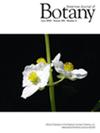Salt tolerance in a neotropical orchid in the absence of local adaptation to salt spray
Abstract
Premise
Salt tolerance has rarely been investigated regionally in the neotropics and even more rarely in Orchidaceae, one of the largest families. Therefore, investigating local adaptation to salt spray and its physiological basis in Epidendrum fulgens, a neotropical orchid species, brings important new insights.
Methods
We assessed the degree of salt tolerance in E. fulgens by testing whether coastal populations are more tolerant to salt, which could point to local adaptation. To understand the physiological basis of such salt tolerance, we exposed wild-collected individuals to salt spray for 60 days, then measured leaf expansion, osmotic potential, sodium leaf concentration, chlorophyll leaf index, chlorophyll fluorescence, relative growth rate, and pressure–volume curves.
Results
There is no local adaptation to salt spray since both inland and coastal plants have a high tolerance to salt stress. This tolerance is explained by the ability to tolerate high concentrations of salt in leaf tissues, which is related to the high succulence displayed by this species.
Conclusions
We showed an unprecedented salt tolerance level for an orchid species, highlighting our limited knowledge of that trait beyond the traditional studied groups. Another interesting finding is that salt tolerance in E. fulgens is linked to succulence, is widespread, and is not the result of local adaptation. We suggest that E. fulgens and its allied species could be an interesting group to explore the evolution of important traits related to tolerance to salt stress, like succulence.

 求助内容:
求助内容: 应助结果提醒方式:
应助结果提醒方式:


